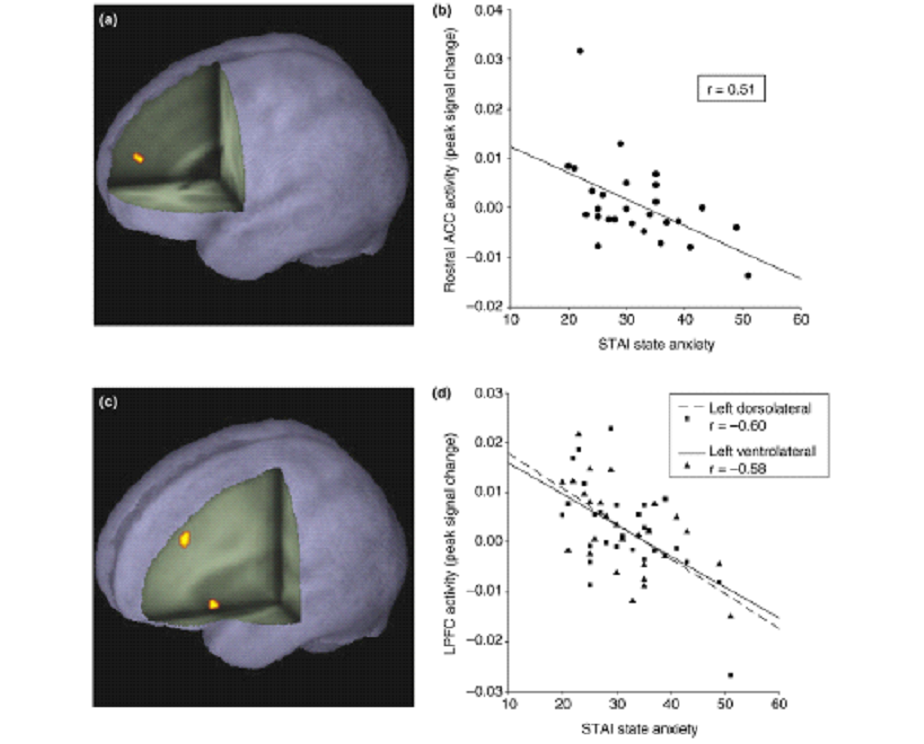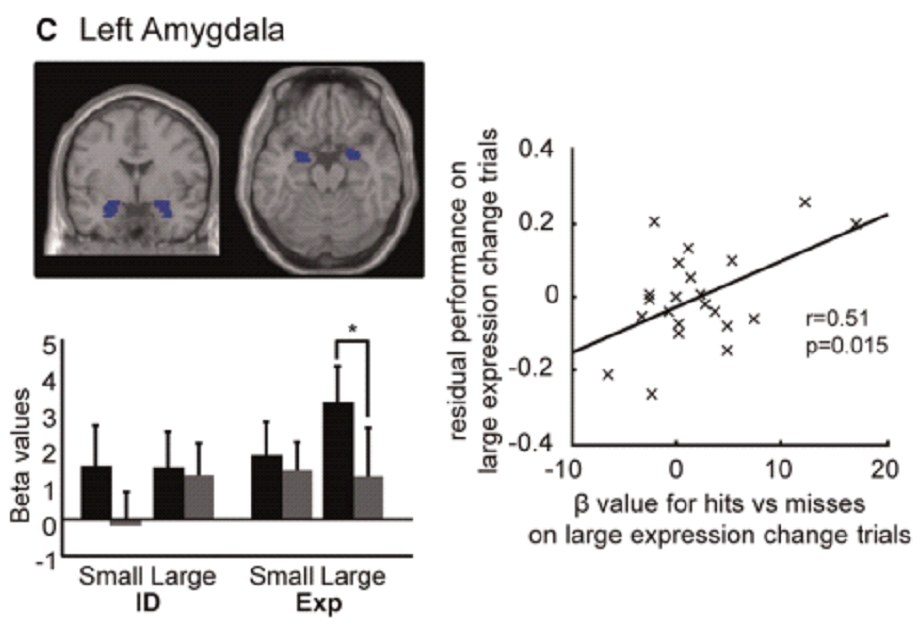The Brain Basis of Attentional Capture by Threat in Anxiety
Both clinically anxious patients and individuals with high trait anxiety (i.e. a dispositional bias to anxiety) are more likely to have their attention captured by task-irrelevant threat stimuli (e.g. faces with fearful expressions). In the early 2000s, it was widely assumed that this was due to anxious individuals having an increased amygdala response to threat stimuli. This assumption was largely driven by findings from the rodent literature implicating the amygdala in fear responses. Desimone and Duncan (1995) had fairly recently put forward the ‘biased competition model of selective attention’ according to which stimulus salience (e.g. color or motion) and top-down cognitive control can exert opposing influences on attentional capture by salient distractors. Applying this model to threat-related attentional biases in anxiety, we have shown that anxiety is not only linked to amygdala hyper-responsivity to threat (i.e. a greater saliency driven response to threat distractors) but also to impoverished recruitment of the frontal mechanisms implicated in attentional control (Bishop et al., J. Neurosci. 2004, Bishop et al., Nature Neuroscience, 2004, Bishop et al., Cerebral Cortex, 2007).

Results from Bishop et al. Nature Neuroscience, 2004.
a) Elevated rostral anterior cingulate (ACC) activity is observed in response to unexpected attentional competition from threat-related distractors; Z = 3.44, p < 0.02 corrected. (b) Across conditions, high anxious individuals show a reduced rostral ACC response. (c) Lateral prefrontal cortical regions responding to increased expectancy of threat distractors as an inverse function of anxiety. (d) Recruitment of both the left dorsolateral (broken line) and left ventrolateral (unbroken line) regions decreases as anxiety levels increase.
Recent Extensions
Most studies of the capture of spatial attention by threat-related stimuli present targets and distractors concurrently or separated at most by 1s. Understanding the time-course of the capture of spatial attention by threat distractors has important implications for real-world settings such as driving. We have demonstrated that elevated trait anxiety is associated with slowed identification of targets occurring several seconds after the offset of distractor faces of ambiguous threat value (part surprise, part fear). This in turn is associated with increased distractor-related activity in the fusiform gyrus and amygdala and reduced dorsal anterior cingulate recruitment, the latter potentially reflecting impoverished recruitment of reactive control mechanisms to damp down stimulus-specific processing in subcortical and higher visual regions (Forster et al., Frontiers in Human Neuroscience, 2014).
In other work, we have also reversed the question of whether amygdala-driven attentional capture by threat can disrupt performance, investigating instead situations where it may be beneficial. Here, our findings indicate that amygdala responsivity to facial fear cues may over-ride the need for engagement of frontal mechanisms when it comes to detecting changes in emotional expression as opposed to other aspects of facial information (Achaibou et al., Social, Cognitive & Affective Neuroscience, 2015).

Amygdala activity is greater for hits vs misses for large changes in expression (trials where expression changed from neutral to 60% fearful) but not for large changes in identity. Across participants, the magnitude of amygdala activity associated with this contrast was positively correlated with performance on these large expression change trials (controlling for general change detection ability as indexed by performance on house change trials). *P < 0.05. From Achaibou et al., Social, Cognitive & Affective Neuroscience (2015)
Is trait anxiety linked to a more general deficit in the function of frontal attentional mechanisms?
The work described above advanced our understanding of the neural mechanisms underlying threat-related attentional biases linked to anxiety, but left open the question of whether trait vulnerability to anxiety is associated with impoverished function of frontal attentional control mechanisms even in the absence of threat cues. This is an important issue as it may throw light on whether impoverished frontal function is potentially a key risk factor in anxiety by helping to eliminate the argument that frontal under-recruitment is merely a secondary phenomenon to amygdala hyper-activity and/or elevated catecholamine release in response to threat stimuli. Hence, we have studied whether high trait anxious individuals show reduced recruitment of frontal ‘control’ mechanisms during performance of attentional tasks with no threat element. Findings from this work indicate that trait vulnerability to anxiety is associated with impoverished frontal control of both selective attention and sustained attention even when emotional stimuli are completely absent (Bishop, Nature Neuroscience, 2009; Forster et al., Cerebral Cortex, 2015). This suggests that the deficit in recruitment of frontal attentional mechanisms in anxiety is much more fundamental than initially believed.
Ongoing/Future Work
We are currently extending this research to examine the extent to which (i) frontal under-recruitment, (ii) amygdala hyper-responsivity or (iii) a combination of both contribute to differences between healthy controls and medication-free patients with Generalized Anxiety Disorder (GAD) and Specific Phobia in performance of attention tasks with and without threat stimuli. We are also interested in computationally operationalizing the anxiety-related alterations in attentional function elucidated in this series of studies.